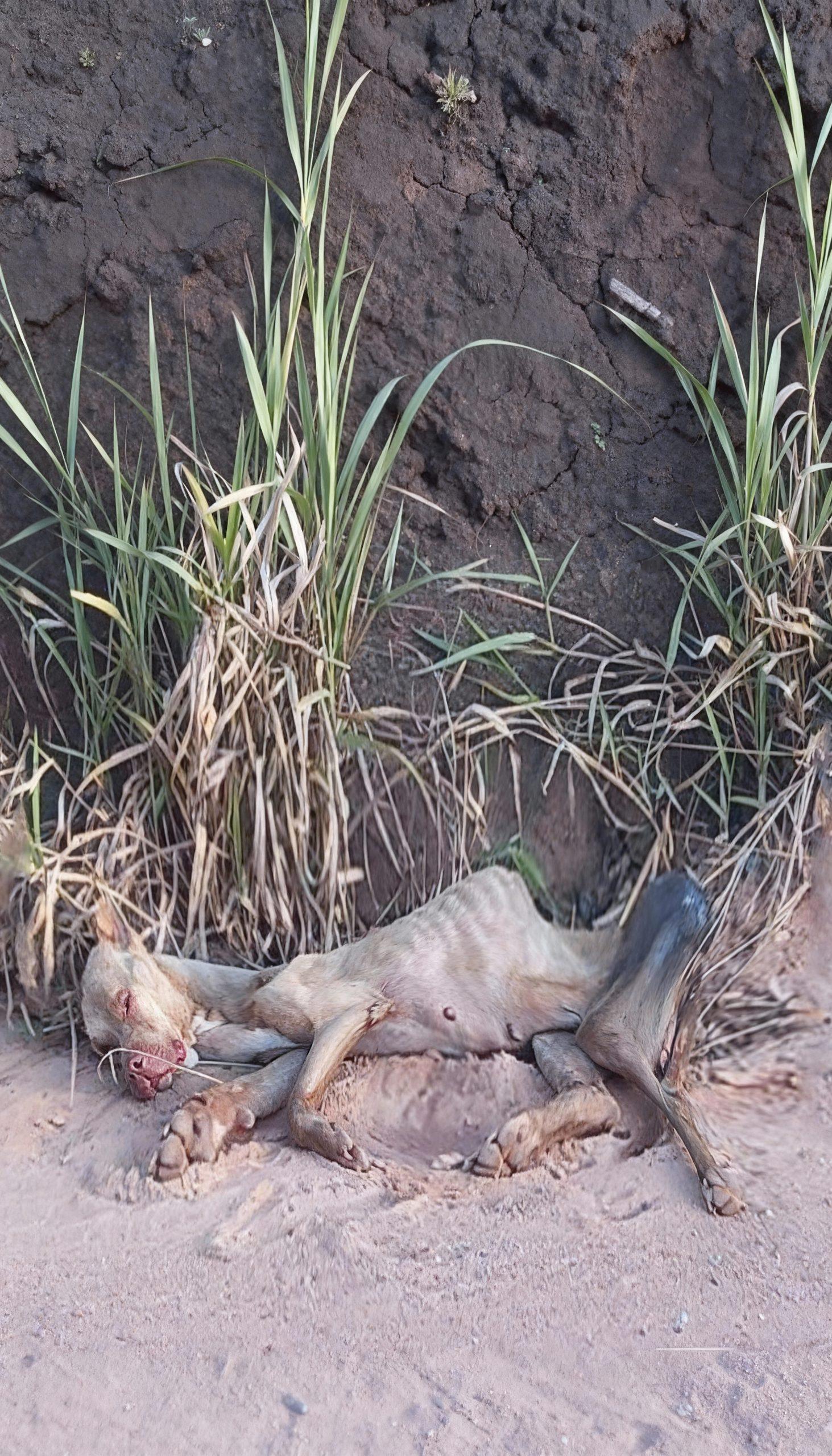The image before us is a stark, unsettling tableau that immediately arrests the gaze and stirs a deep sense of disquiet. It depicts a canine, likely a dog, lying motionless on what appears to be sandy or dusty ground, nestled against a backdrop of dark earth and sparse, dry vegetation. The animal’s posture is one of complete surrender, its body emaciated to an alarming degree, ribs painfully prominent beneath a thin, matted coat. Its head is turned slightly, revealing an open mouth and what could be interpreted as a final, silent cry. The eyes, though not clearly visible, seem to convey an absence, a void where life once flickered. The forelegs are splayed, paws open, while the hindquarters are contorted, suggesting either rigor mortis or a desperate struggle in its final moments. A patch of darker fur or perhaps even decay is visible on its lower back, further emphasizing the dire state of its existence. The surrounding environment offers little comfort: dry grass stalks stand testament to a parched landscape, and the earthen bank behind suggests a forgotten, desolate location. There’s an undeniable rawness to the scene, an unfiltered portrayal of suffering that transcends species. This isn’t just an image of a deceased animal; it’s a profound visual narrative of neglect, abandonment, and the agonizing process of a life fading away, unnoticed and unhelped. It forces us to confront uncomfortable truths about our relationship with the creatures we share our world with, compelling us to look beyond the surface and consider the silent stories of countless others who endure similar fates.

`The sight of such profound emaciation immediately raises questions about the circumstances that led to this tragic end. Was it starvation, disease, or perhaps a combination of both? The prominent ribs and sunken flanks speak volumes of prolonged nutritional deprivation, a slow and agonizing decline that could have been prevented with adequate care and feeding. In many parts of the world, stray animals face a relentless battle for survival, scavenging for scraps, often competing with each other and enduring harsh environmental conditions. This particular image serves as a powerful reminder of the vulnerability of these creatures when left to fend for themselves, highlighting the critical role human responsibility plays in their welfare. The absence of any visible signs of recent human interaction – no collar, no discernible tags, no discernible shelter – further underscores the likelihood of abandonment or a life lived on the fringes of human society, where compassion and intervention were tragically absent.

Beyond the physical suffering, there is an emotional weight to this image that is difficult to ignore. The animal’s stillness suggests a finality, a life extinguished not by sudden accident but by a gradual, unrelenting erosion of vitality. This slow fade often comes with its own unique torment, characterized by escalating weakness, hunger pangs that gnaw incessantly, and the silent understanding that help is not coming. Animals, like humans, experience pain, fear, and distress, and to imagine the protracted suffering this creature must have endured before its eventual demise is truly heartbreaking. The natural setting, with its dry grass and dusty ground, only amplifies the sense of isolation, suggesting that this final act unfolded in a place where companionship and comfort were distant memories, if they ever existed at all.

The presence of the dark earth bank and sparse vegetation in the background further contributes to the overall mood of desolation. This is not a manicured lawn or a bustling street; it is a raw, untamed corner of the world, where life and death play out with unvarnished honesty. The dry grass stalks, brittle and brown, mirror the animal’s own fragility, while the dark earth seems to absorb any lingering hope or vitality. This environment speaks to a place removed from human intervention, a silent stage where the ultimate drama of survival and demise unfolds without witnesses or mourners. It’s a powerful visual metaphor for the forgotten, the unseen struggles that occur daily in countless hidden corners of our shared planet.







